Japan Wood Products
Prices
Dollar Exchange Rates of
10th October 2014
Japan Yen 107.65
Reports From Japan
BoJ puts on a brave face
The tone of the Bank of Japan‟s (BoJ) latest statement on
the economic prospects was not as optimistic as over past
months. While acknowledging the slow recovery of
consumer spending after the tax increase was a surprise
the level of monetary easing was not expanded.
The statement from the BoJ highlights weak housing
growth and stalled industrial production as responsible for
the sharp contraction of GDP in the second quarter.
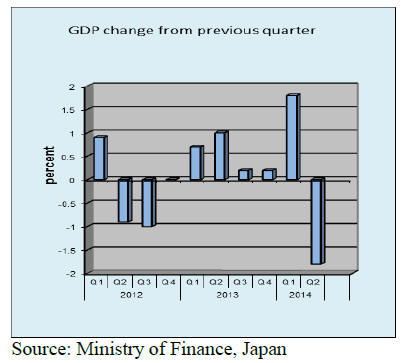
Despite the somber economic news the BoJ governor
talked up prospects saying within the remainder of the
year factory output and consumer spending would grow.
See:
https://www.boj.or.jp/en/mopo/gp_2014/gp1410a.pdf
Coincident Index drops
Japan‟s Cabinet Office gauges the current state of the
economy through a survey of trends in employment, real
earnings, average weekly hours worked in manufacturing
and the unemployment rate. This data is combined to
produce a 'Coincident Index‟. The coincident index for
August fell to 108.5 from 109.9 in July.
For a description of items assessed for determining the
coincident index in Japan see:
http://www.esri.cao.go.jp/en/stat/di/111107components.ht
ml
The Index was in posi
tive territory from January to March
but weakened significantly after the consumption tax
increase in April. The assessment of the Index from the
Cabinet Office is shown below.
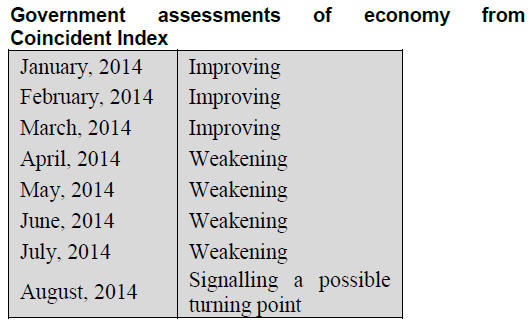
Machinery Orders
The level of machinery orders in Japan, an indicator
private sector sentiment on capital spending, rose in
August, marking the third monthly increase.
However, the quarterly data from Japan‟s Cabinet Office
as well as the third quarter forecast from the government
are more revealing.

The forecast is for core machinery orders to fall
dramatically in the third quarter of this year as companies
wait to assess the government‟s stance on a further
consumption tax increase scheduled for early 2015 which
is sure to hit consumer spending once more.
See: http://www.esri.cao.go.jp/en/stat/juchu/1408juchue.
html
Weak yen drives up small company bankruptcies’
The yen bounced back slightly from the low of 110 to the
US dollar, marking the biggest gain since February. The
yen was given a boost after the governor of the Bank of
Japan said the Bank will closely monitor the exchange
rate, a hint that action may be forthcoming to halt the
yen‟s slide.
The Prime Minister has voiced concern that the weak yen
is hurting small businesses. Over the past months there has
been a rise in bankruptcies amongst small companies
which suffer when the cost of imported raw materials and
when energy costs rise without a corresponding increase in
their sales prices.
There is a heated debate at present in Japan on whether the
weaker yen is good or bad for the economy. Certainly,
exporters benefit but small companies which rely on
imported materials are badly affected as are low income
households.

Consumer confidence
The Cabinet office assessment of consumer confidence fell
for a second month in September. Most analysts had
forecast an improvement.
The overall livelihood index fell to 37.1, the sharpest fall
amongst the various indices. The index measuring
willingness to buy durable goods fell to 37.8 and the index
measuring employment and income growth also fell.
All indices below 50 signal underlying consumer
pessimism for the short-term.
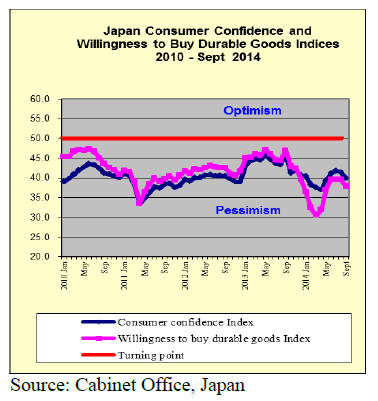
Surprising rise in holiday season housing starts
August is traditionally the month where housing starts are
low simply because it is the month for company holidays.
Given that in August around 10 days are lost to holidays, it
is a surprise to see August housing starts rise to 73,700.
An increase in August starts is an indicator of just how
low starts have been over the previous 6 months.
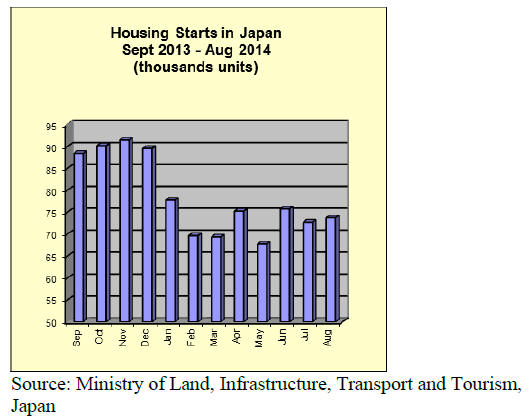
Trade news from the Japan Lumber Reports (JLR)
For the JLR report please see:
http://www.nmokuzai.
com/modules/general/index.php?id=7
Impact of weakening yen
The yen has been rapidly weakening in recent weeks,
reaching almost 110 yen per dollar. The reason is
expectation of strong dollar by coming higher interest rate
in the U.S.A.
Weak yen pushes cost of imported products. Wood
products market has been suffering from declining demand
after the consumption tax increased since last April and
this is additional negative news for sluggish housing
market.
Buyers of wood products are not so concerned to the
exchange rate with weak demand so any item, which has
not production or import curtailment, is facing dropping
market prices then came weak yen.
Therefore, import curtailment is inevitable with weak yen
and sluggish demand. For instance, in imported South Sea
hardwood plywood market, current prices of JAS 3x6
concrete forming panel are about 1,200 yen per sheet
delivered but the suppliers‟ export prices are about
US$565 per cbm C&F, which costs about more than 1,350
yen per sheet so 150 yen per sheet price increase is
necessary but users have ample inventories through
October so sharp price hike is unlikely.
North American Douglas fir log export prices rebounded
in September after six months. DF sawmills in Japan need
to reduce purchase volume and the mills cannot afford to
reduce sales prices of Douglas fir lumber in Japan.
Imported Douglas fir lumber export prices are US$465-
470 per cbm C&F on KD 105 mm square, which costs
about 51,000 yen per cbm FOB truck port yard but the
market prices are less than the import cost. It is hard for
the suppliers to give 5% export price reduction to cover
depreciation of the yen.
Tama Home goes to India
Tama Home Co., Ltd. (Tokyo) announced that it will
establish a joint venture company in India. It will invest
Developer Group Private Limited (DG), a developer in
India. DG has the head office in Singapore and does real
estate development in India through its 100% subsidiary
company in India.
In India, five million units of detached house and there
are total of 280 million units already built. Housing market
in India has been rapidly expanding so Tama Home thinks
India is promising market including renovation business so
it decided to start business in India.
Tama Home will actively participate building of detached
units DG‟s subsidiary company has been doing.
Tama Home will work together with DG for the business
Tama Home has been doing in India like condominium
development of about 1,000 units in Chennai.
July plywood supply
Total plywood supply in July was 520,900 cbms, 6.9%
less than July last year and 3.8% less than June.
Production curtailment by domestic plywood mills is the
reason of the decrease. Import plywood continued
declining under 300,000 cbms for two straight months.
Total imported plywood volume in July was 291,000
cbms, 6.9% less and 1.0% less. Monthly average import
for the first seven months was 310,000 cbms, 2.3% less
than the same period of last year.
Malaysian supply has declined for three straight months.
July volume was 112,300 cbms, 13.8% and 3.8% less.
Average for the first seven months was 130,500 cbms,
10.3% less than the same period of last year.
Indonesian supply in July was 93,500 cbms, 1.7% less and
3.9% more, two straight months‟ increase.
Some importers estimate August arrivals would be down
to about 260 M cbms then September would recover to
nearly 300,000 cbms again.
July production of domestic plywood was 229,800 cbms,
6.9% less than July last year and 7.1% less than June, out
of which softwood plywood was 213,300 cbms, 7.7% less
and 7.9% less. Monthly average production for the first
seven months was 223,200 cbms, 4.3% more than the
same period of last year due to active market in the first
and second quarters.
Average monthly production in 2013 was 218,900 cbms
then assuming 10% less for shrinking market this year,
monthly production should be 197,000 cbms.
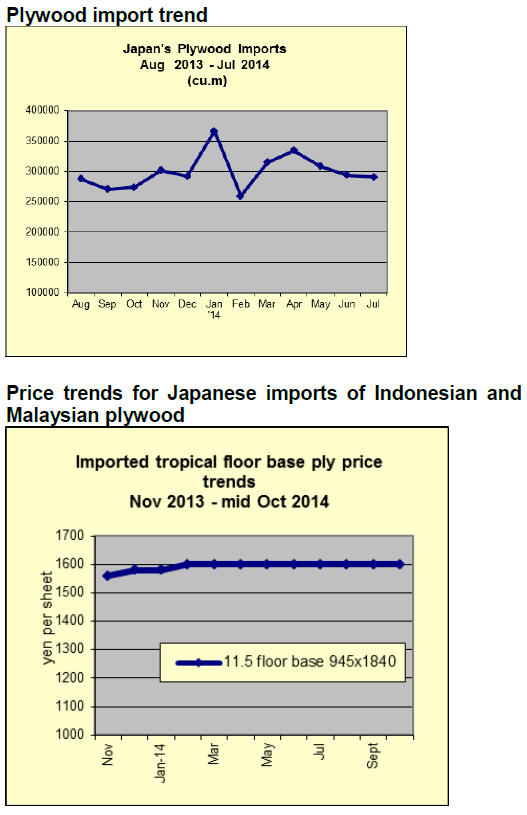 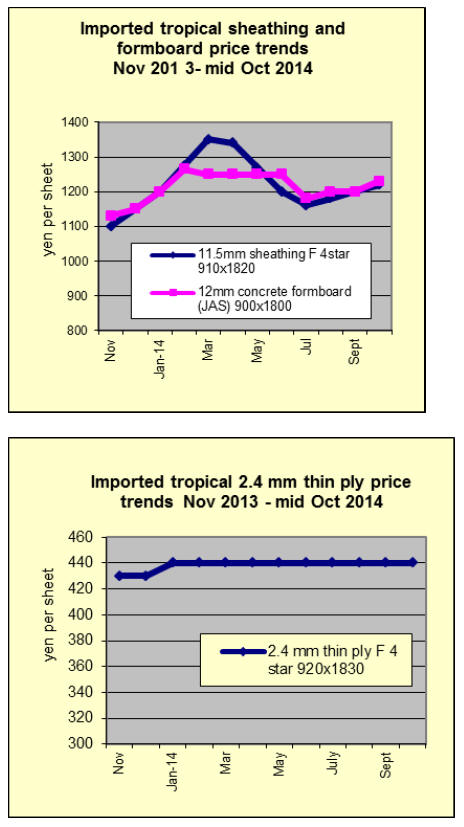
Ishii Trading markets Vietnamese plywood
Ishii Trading Co., Ltd. (Osaka) has started marketing
Vietnamese plywood for engineering works construction
materials. The brand name is „Platform veneer‟.
The first shipment of 10,000 sheets arrived in early
August. Initial target of sales is 20,000 sheets a month
mainly in Tokyo market then eventual target is 50,000
sheets a month. Ishii Trading was established in 1958 and
has been handling traditional Japanese furniture and
paulownia for wood working. Now it handles housing
materials such as plywood, lumber, MDF, particleboard,
LVL and laminated lumber.
Vietnamese plywood is made out of both natural species
such as keruing plantation timbers.
To reduce the cost, it mainly uses core veneer so that the
cost is about 10% lower than normal imported plywood
used for earth retaining board.
Size of the plywood is 11 mm thick, 900 mm wide with
length of 1,800 mm. Ishii thinks that the demand of
engineering works materials should be firm through 2020
as the Olympic Games will be held in Tokyo in 2020.
Radiata pine logs and lumber
There is some change in New Zealand log export prices.
Radiata pine log prices for China peaked at US$163 per
cbm C&F in last spring then China reduced the purchase
so that the export prices plunged down to US$120 in July.
New Zealand log suppliers reduced the supply so the
prices started firming since last August and now the prices
are US$15 higher than the bottom prices. Log inventory in
China is reported about 4,300,000 cbms, which is
excessive to the demand but China started buying again
after the prices dropped so much and the supply get tight.
The most recent prices for China are US$135-137 per cbm
C&F.
A sort log prices for Japan were US$155-158 per cbm
C&F for late July and early August shipment, US$5 lower
than June shipment.
The prices for late August shipment are unchanged from
July shipment but September prices are likely to go up
after China prices rebounded.
South Sea(tropical) imported hardwood
The plywood market is firming particularly after the yen‟s
rapid depreciation. Future FOB prices contracted in early
September are considerably higher. Steep increase of
export prices is likely to reduce the contract volume so
future arrivals would decline.
Therefore, the dealers are now trying to raise the sales
prices gradually since their holding inventories are now
valuable.
Supply side has been increasing the export prices by
US$10 per cbm every month since last July by high log
cost and current prices are about US$565 per cbm C&F on
JAS 3x6 concrete forming panel. Once supply region gets
into rainy season, further increase is likely.
Increasing log exports from Kyushu
Total log export of domestic species by Japan in 2013 was
264,000 cbms, 133% more than 2012. Main source of log
export is Southern Kyushu. It is reported that the total log
export from the Southern.
Kyushu in the first half of this year already surpassed the
volume exported in the same period of last year so total
year export is likely to double of 2013. Recent trend of
weak yen is obviously helping expansion of log export.
In Miyazaki prefecture, log export in 2013 was about
46,000 cbms then in the first half of this year, the same
volume was exported.
Forest Unions in Kagoshima and Miyazaki prefecture
formed log export strategic council. Port of Shibushi,
Kagoshima prefecture shipped out 24 M cbms in 2013, 3.7
times more than 2012.
In Ohita prefecture, prefectural log export for the first half
of this year exceeded 20,000 cbms, which is last year‟s
total export.
In Kumamoto prefecture, total value of forest product
export in 2013 was more than double of 2012. Export log
prices vary by log length, diameter and quality but
generally, they are 7,000-9,000 yen per cbm delivered at
loading ports.
Destinations are China, Taiwan and Korea. The volume
for Taiwan and Korea has been steady but the volume for
China is sharply increasing.
|